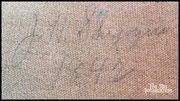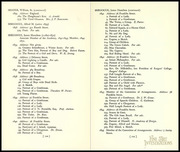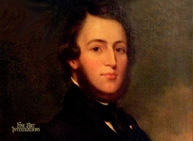“Who was the artist?” the owners wanted to know. The Portrait of an Unknown Gentleman was an especially hard project because the painting had little provenance. The owners purchased the portrait in Wisconsin at auction. The estate may have been from Iowa, but the owners, antique dealers, thought the portrait looked southern. The only other clue was a nearly illegible signature at the upper right on the back of the relined painting.

Portrait of an Unknown Gentleman, 1842 
Portrait of an Unknown Gentleman Signature and date (verso)

The placement and the illegibility reminded me of other portraits where a family member had scrawled the sitter’s name to preserve the name of the ancestor. When signing the back of a canvas, antebellum portrait artists usually printed their names with precision, or at the very least, with artistry. The first initial “J.”, was fairly clear, as was the date, 1842, but the middle initial? The last name?
Puzzling
“Watson” and I puzzled over the name. We enlarged it, changed the contrast, the color, tried various name combinations and attempted to match the various permutations with lists of artists and census records. We could not decipher a combination of letters that fit any name.
In the meantime, without provenance, I could give only a non-binding attribution. I compared Portrait of a Gentleman to examples from hundreds of antebellum American artists. The work of the peripatetic pair of artists Trevor Thomas Fowler (abt. 1800-1881) and Theodore Sidney Moise (1808–1885) seemed most comparable, for example, The Children of Orlando Brown, in the eyes, eyebrows, mouths, stance of the subjects, and in the corner foliage. I must emphasize that this was a non-binding attribution. The owners saw the resemblances, too. I promised them that I would continue to try to find the name of the sitter.
Solving the Mystery
When I returned to the portrait. I printed out the best rendition of the signature and tried several different research paths but, as before, every attempt led to a dead end. But, I kept the piece of paper on my desk and glanced at it from time to time to see if a name would materialize. In the midst of a completely different research project, I came across a hauntingly beautiful Portrait of an African-American Woman at the Morris Museum of Artin Augusta, Georgia. The pose, the expression, the technique, all echoed Portrait of an Unknown Gentleman. The portrait artist was James Hamilton Shegogue (1806-1872). Suddenly, the scrawl on the back of Portrait of Unknown Gentleman became was readable: “Ha. The name identified the artist, not the sitter. Judging simply by the portrait at the Morris, Shegogue’s better style fit Portrait of Unknown Gentleman than did the style of Theodore Moise. Both men were from Charleston, South Carolina, and were nearly the same age. Could they have studied together? Known one another? Shared techniques? Is that why I saw a similarity?
Next came the quest to find more examples by Shegogue. Through the Inventory of American Paintings, I found a small handful of images of drawings, prints, and a poor photograph. The Frick Art Reference Library was the best resource, with 15 black & white images.
The Artist
Equally frustrating was the search for biographical information. I was able to learn that James Hamilton Shegogue was born in Charleston, South Carolina, on February 22, 1806. By 1833, he was in Connecticut, where he married Sarah Hamilton Lord (1812-1906). James and Sarah would have three children. In 1834, Shegogue exhibited three paintings at the National Academy of Design. In following years, the Academy included increasing numbers of his artworks. He was elected an Academian in 1843. In 1849, members voted him onto the board for a three-year term as corresponding secretary.
I reviewed records of the National Academy. In 1842, Shegogue exhibited four portraits of a “Gentleman.” The portrait pictured above may be one of those.

1834-1845

Detail from 1842
The New York Historical Society owns J. H. Shegogue’s copy of the Henry Inman (1801-1846) portrait of Nicholas Fish. Shegogue expressed his admiration for Inman in an 1855 note to his friend Thomas Seir Cummings (1804-1894): “It gives me great pleasure to accept as a memento of our friendship the sketchbook of our late friend Henry Inman. Nothing that you have selected would be more esteemed by me”((Cummings Papers, James Hamilton Shegogue to Thomas Seir Cummings, December 27, 1855, reel NC1, frame 198, in Teresa A. Carbone, American Paintings in the Brooklyn Museum, Artists born by 1876, Volume 2 (D. Giles, 2006), 943.))
Shegogue retired to Warrenville, Connecticut, in 1862. “His reputation faded rather quickly and today he remains an obscure figure among mid-nineteenth century New York artists.”((Ibid.)) He died in 1872.
Afterword
Now, when I look at the scrawled signature from Portrait of an Unknown Gentleman, all I see is “J. H. Shegogue.” Some mysteries are easier to solve than others. Portrait of an Unknown Gentleman was not one. The antique dealers who own the painting enjoy the portrait on the wall of their home. Now they know the subject was probably a young man from New York City. Since this long-term project began, an 1833 portrait by James Hamilton Shegogue appeared in the marketplace. Last week, Christie’s sold a multi-figured Civil War genre work, The Zouave Que Vive, by Shegogue for a respectable hammer price of $32,000 — $40,000 with buyer’s premium. Like the words scrawled on the back of Portrait of an Unknown Gentleman, is the name of James Hamilton Shegogue rising from near anonymity?

